6sense vs. Bombora (+ One Option You Should Consider)
In London, you’ll see high-end sports cars puttering around the streets.
Maserati. Lamborghini. Aston Martin. Ferrari. All of them inching their way around in streets full of traffic and pedestrians. Barely getting above 20 KPH.
Fun to watch, but ultimately the wrong tool for the job.
And the same can happen with the tools we choose for our jobs.
If you’ve landed here, it’s because you’re trying to decide whether 6sense or Bombora is the right tool for you.
But here’s where you need to start: first, ask yourself exactly what you need before you choose a tool.
Because if you’re just put-putting around London, you probably don’t need a Lamborghini.
Or, if you’re racing on the F1 track, you probably shouldn’t be in a Smart.
Both 6sense and Bombora surface buying intent data, but in different ways. We’re going to show you how they differ, when they work best, and where they’re lacking.
But remember, the biggest gap in both of these products is the same: neither offer you contact-level insights.
That’s why we’re also going to introduce you to Influ2, a contact-level ABM option, and show how it can fundamentally change your ABM strategy.
| 6sense | Bombora | |
| Intent data | Mix of first-, second-, and third-party signals (website activity, reviews, technographics, plus partner data). Updated in near real-time. | First-party and third-party data with Company Surge intent. Tracks consumption on 5,000+ websites and provides account-level surge scores updated weekly. |
| Predictive scoring | AI-driven analytics, with customizable predictive models that you can train for your specific needs. | No built-in predictive model. Delivers signals that you can feed into your own scoring. |
| Built-in advertising | Yes, includes built-in ABM ad tools with domain targeting on multiple channels. | No, but offers direct integrations with ABM advertising tools. |
| Website deanonymization | Yes | Yes |
| Ease of use and onboarding | Typically takes longer to set up and learn. | Typically shorter ramp-up time and easier to integrate into a team’s existing workflow. |
| Pricing model | Enterprise-tier subscription, typically tens of thousands per year for the entire ABM suite. | Usage/credits-based for intent data. Generally cheaper if you only need intent data signals. |
| Best for | Large, mature ABM programs that need an all-in-one platform for account scoring, orchestration, and sales enablement in one place. | Marketers who need high-quality intent signals to feed into their existing tech stack. |
Defining differences and overlap between 6sense and Bombora in 4 main areas
6sense is an end-to-end ABM platform that leans heavily on its AI-driven features. It offers intent data, website visitor deanonymization, and account-level advertising capabilities.
Bombora, on the other hand, specializes in providing deep intent data. Its overall ABM features are more limited, but that focus gives it an edge.
Let’s break down how each of these tools differs in the areas that matter most to ABM teams.
Intent data capabilities
Both 6sense and Bombora offer you all three types of intent data: first-party data added from your own website visits, second-party data through review sites, and third-party data at a large scale, covering keyword mentions and engagement.
6sense is designed to show buying intent for both sales and marketing teams. Its Signalverse claims to pull in over a trillion pieces of B2B data every day, giving users a broad view of account-level web visits, content consumption signals, predictive firmographics, and more.

With it, you get:
- Multi-source data integration: 6sense aggregates data from G2, TrustRadius, TechTarget, and even Bombora itself, to provide insights into account behaviors and show you who’s in-market.
- Predictive analytics: The platform takes the data it gathers and uses AI to predict where accounts are in the buying journey and their level of interest.
- Account identification: 6sense can identify anonymous website visitors by matching IP addresses to accounts, showing which companies are engaging with your content.
Bombora specializes in giving you intent data based on the research behavior of businesses across the web.
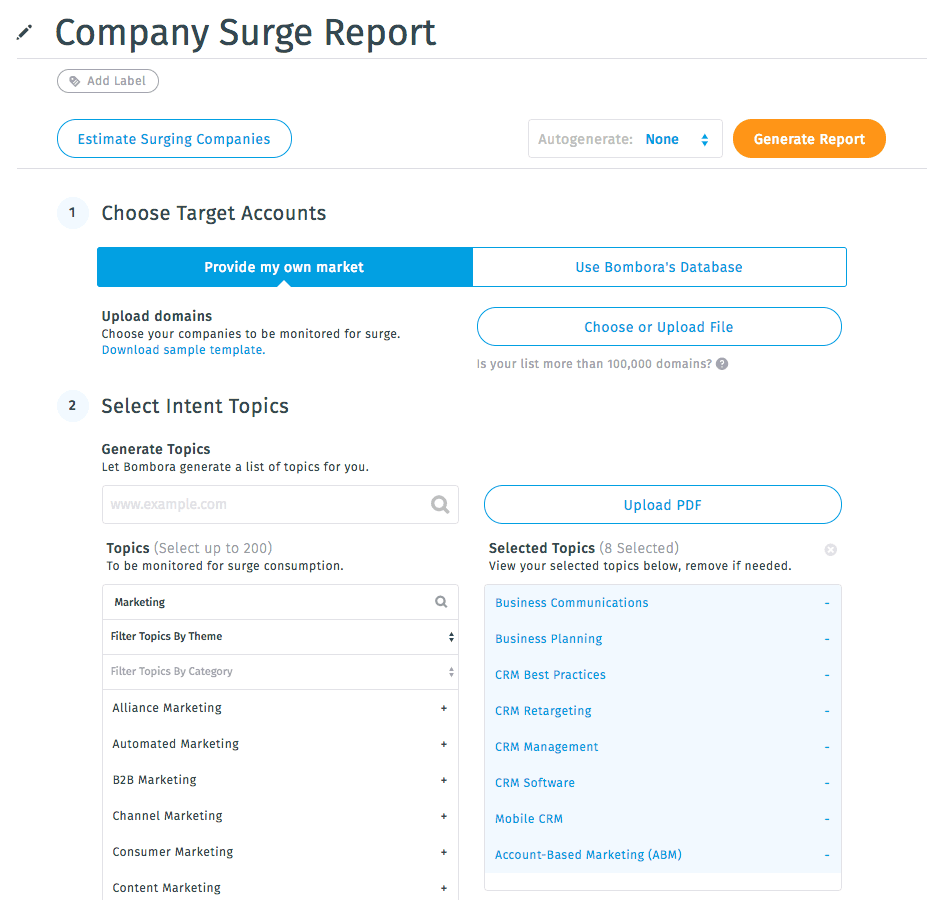
It offers:
- A wide range of data: Their intent data co-op anonymously tracks content consumption across 5,000 business websites, and categorizes the content into 12,000 topic clusters.
- Company Surge: Bombora’s flagship product identifies when businesses are actively researching specific topics compared to their historical baseline.
- Integration of intent data to other systems: Bombora makes it very easy to share their intent data and Surge scores with other systems, meaning you can see intent where you want it, not necessarily just in Bombora.
Key takeaways
- Both tools offer deep intent data based on thousands of signals, analyzed by AI, and presented to you in a variety of ways (depending on what’s best for your team). Both tools also give you website deanonymization.
- 6sense acts as an all-in-one ABM tool, so if you’re looking for a full-fledged solution that includes intent data, this may be a better option.
- Bombora is a dedicated intent tool for ABM, so if you already have an ABM stack and only need intent data, this may be a better choice for you.
To succeed at ABM, your team needs intent data that goes beyond the account level
Both 6sense and Bombora offer intent data at the account level, which means you’ll see that Acme Inc. is researching a topic related to your product, but you won’t know who inside that company is actually interested in purchasing (or if the person researching is even part of the buying group).
That’s where Influ2 makes the difference for ABM teams.
Instead of telling "someone" at a company is researching topics related to your product, Influ2 tells you who. You sync contact lists from your CRM and Influ2 will show when those people are researching relevant topics across search, social media, and third-party content.
Account prioritization
Both 6sense and Bombora offer tools to help you identify and prioritize the right accounts, but they approach this goal differently.
6sense tries to take the collective data that they gather, plus the historical data of your own deals, and turn that into predictions of which accounts are likely to buy, and when.

Here’s what you’ll get:
- Predictive modeling that you can train and adjust: 6sense’s 6AI product takes in all the information from its Signalverse, and predicts a buying stage and likelihood to convert based on how closely an account’s behavior matches your best customers. You can even train the predictive model, although some users mention that this adds a lot of time on the frontend to get the product set up.
- Dynamic audiences for advertising: You can create a custom audience based on 80+ factors, and 6sense will continuously update your audience segments based on real-time behavior, so you always have fresh leads to target.
Here’s how one user describes it: “The fact that it brings first and third party data together, intent, and profile fit mapping into a centralized model makes it very straightforward to decide who to target—when, why, and with what.”
On its own, Bombora gives you raw intent signals, showing you when a company is researching your product or category.
The benefit is clarity: you know exactly why an account is flagged (e.g. they read five articles on cloud security), but the downside is that you may need another system to sort and score accounts based on more than just what people are researching online.
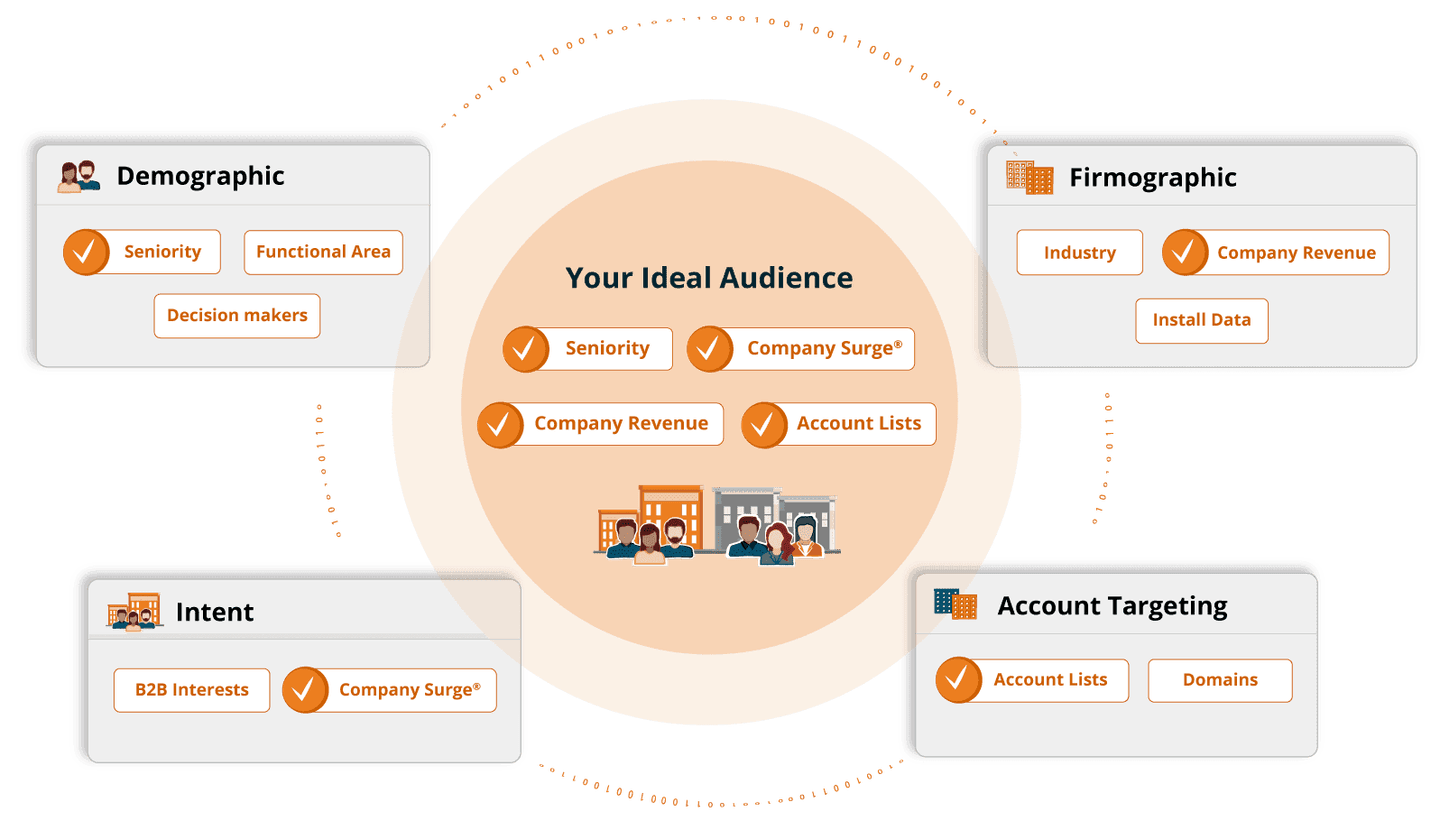
Here’s what Bombora offers:
- Audience creation: Build your own target audiences using Bombora’s database. Filter for things like firmographic, demographic, and technographic data, alongside intent data.
- Automated Surge reports in your CRM: Many teams using Bombora set up a weekly Surge report that goes directly to their CRM, meaning you can prioritize accounts that are showing interest in your product.
As one user says: “It helps me target certain accounts right away without having to do as much research on my own. Immediate scores tell me “hey, this company might be looking to solve problems that your solution does.”
Key takeaways:
- Bombora works best as a building block for your own analytics rather than a turnkey solution for prioritization. It’s also good for quick scores and more high-level prioritization based solely on intent.
- 6sense combines data and AI to give you a list of high-priority accounts, and their models try to work out what stage of the buying process an account might be in. The view you get from 6sense in general is broader, but can take longer to set up.
All this said, there’s a much better way to prioritize accounts with both Marketing and Sales in mind, using Influ2 (more on that below).
Advertising and activation
The next step in your ABM process is connecting with your key accounts—through targeted ads, sales outreach, and other engagement strategies.
Both 6sense and Bombora can help you in this next step, but they offer distinct approaches tailored to different needs.
We’ve already said that 6sense is an all-in-one solution for ABM. In this case, that means you can build your audiences, see intent data, gather analytics, and start advertising directly within the same platform. Basically, your entire campaign can be run from 6sense, from start to finish.
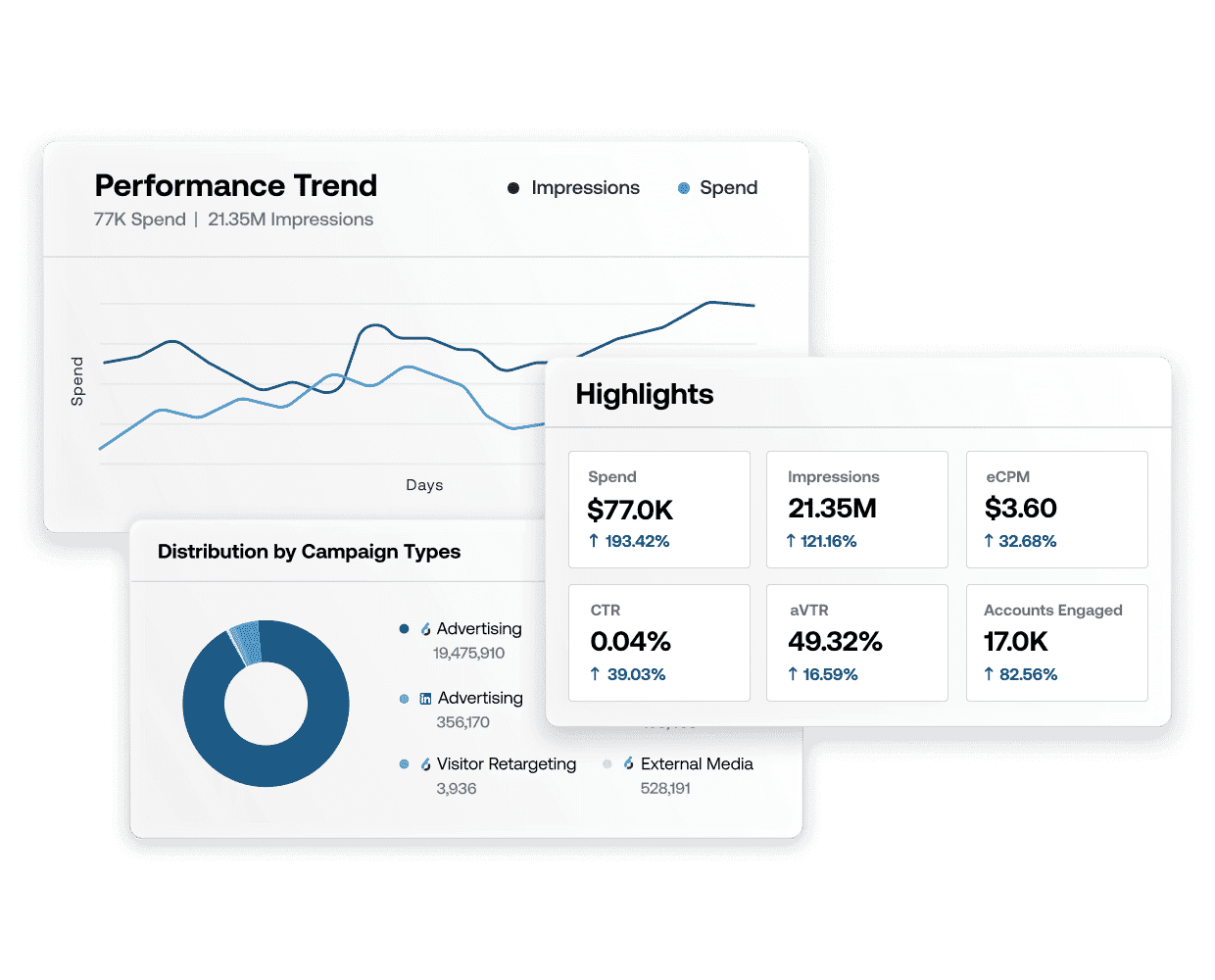
Here’s what they offer:
- Built-in DSP to distribute ads to target accounts: You don’t need to go anywhere—6sense has its own integrated campaign management system, meaning you can launch display, retargeting, contextual targeting, and LinkedIn campaigns directly.
- Dynamic audience segmentation: With a mix of AI and intent data, 6sense allows you to set the criteria for the audience you’re targeting, and the system will dynamically update the list based on buyer behavior.
- Advanced targeting options: The platform gives you granular control over ad placements, including device type, inventory type, domain targeting, and brand safety options.
Bombora does not have a built-in advertising system. Instead, it’s built to play well with the rest of your marketing stack and provide intent data that can be integrated to the advertising platform of your choice.
- Flexible audience segmentation: With over 560 B2B audience attributes, Bombora helps you create highly customized audience segments based on firmographics, behaviors, and interests.
- Integration with advertising platforms: Bombora’s data can be integrated into various demand-side platforms (DSPs), supply-side platforms (SSPs), and customer data platforms (CDPs), making it easier to target advertising across different channels.
Key takeaways:
- 6sense is best if you want to run your entire ABM campaign from one platform. Out of these two options, it’s the only one with a built-in DSP.
- Bombora is ideal for teams who already have a well-developed advertising stack, and simply want to layer in intent data to their targeting. It integrates well with The Trade Desk, Meta, Taboola, and more (although some users mention that the integration with LinkedIn Campaign Manager is a more manual process).
Ready to go beyond targeting accounts? It’s time to activate people
Influ2 is provides contact-level ABM. When you have a clear account list and have identified the buying group in your target accounts, you can use Influ2 to target those people directly with ads.
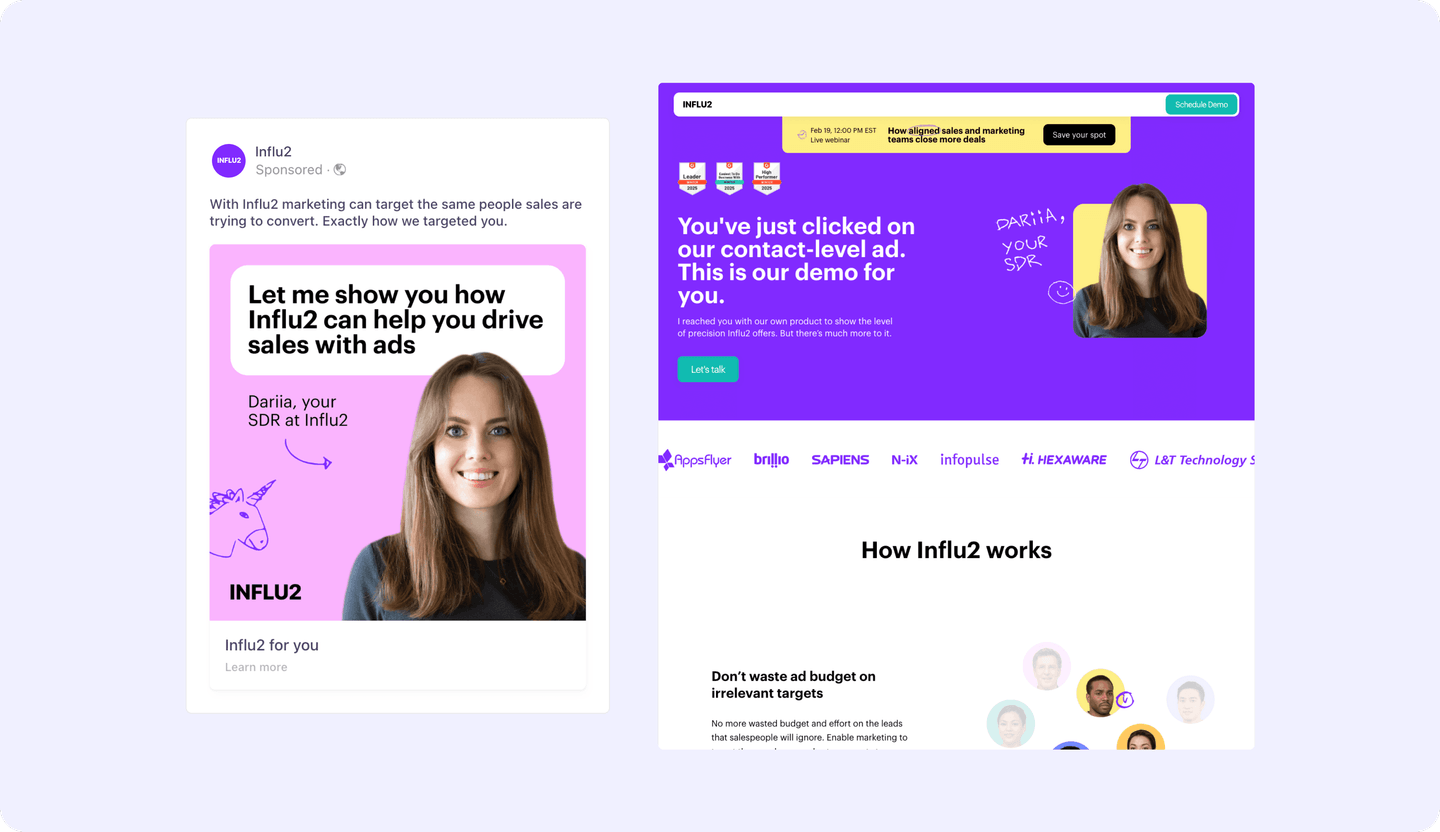
That means you can stop advertising to a domain (where everyone in the company sees your ad, whether they’re part of the buying group or not) and start advertising directly to the people who matter.
You can even build campaigns for specific roles or use cases, narrowing down your messaging to apply to that persona.
Sales enablement and insights
Enabling your sales team is a key aspect of ABM, especially since this strategy works best when there’s alignment across Sales and Marketing. Here’s how 6sense and Bombora help.
6sense gives sales teams a suite of tools designed to prioritize accounts, personalize outreach, and even automate workflows.
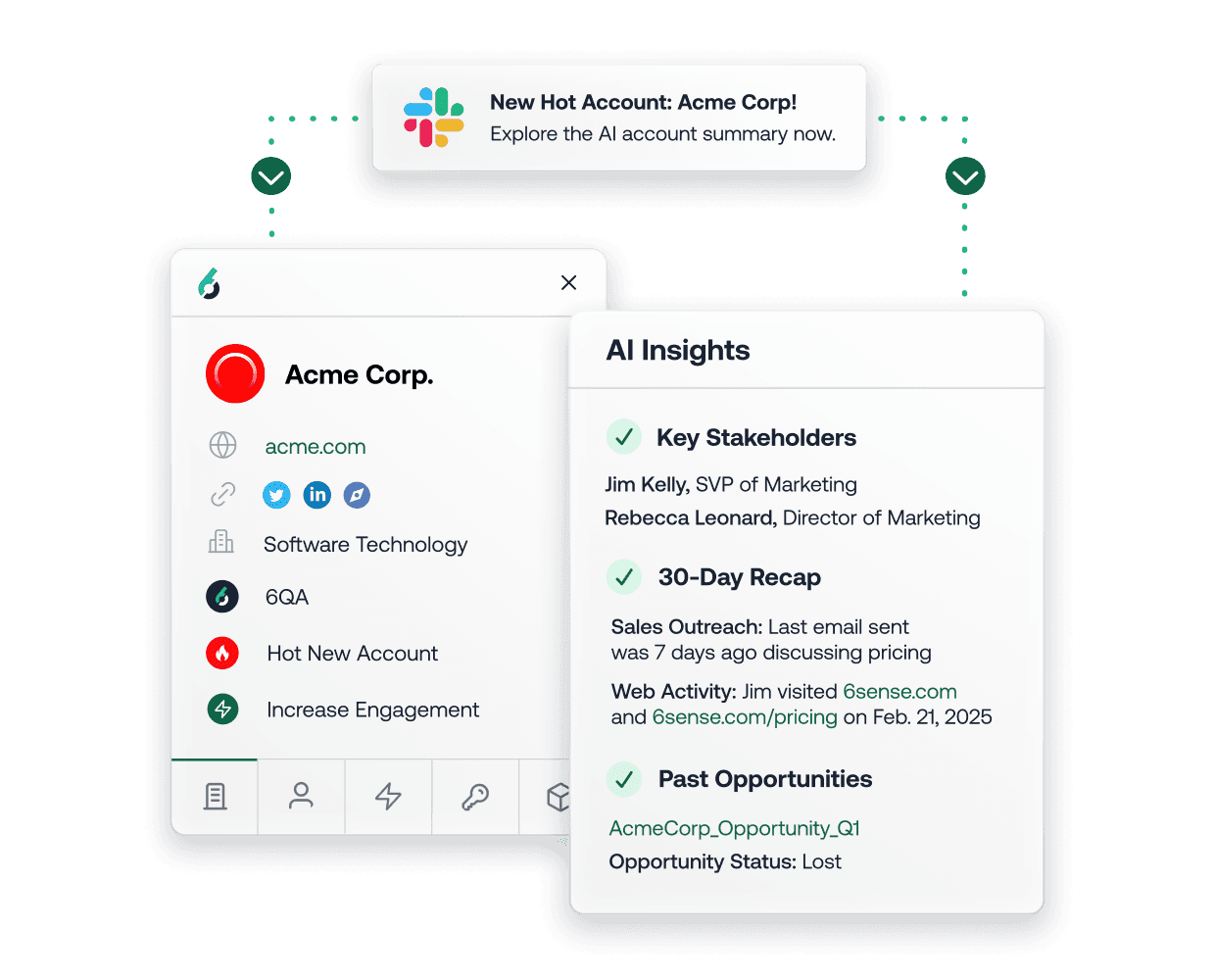
Here’s what you’ll get:
- Dashboards designed for Sales: 6sense gives you several sales-focused dashboards, including a customizable prioritization dashboard that shows in-market accounts and suggests next best actions, and sales intelligence dashboards integrated into the CRM systems your sales team is already using.
- Guided actions with Sales CoPilot: 6sense gives your team AI-driven recommendations of who to contact, what messaging resonates best, and when to engage. It can even help you write personalized emails based on account intelligence.
- Built-in workflow builder: 6sense offers a drag-and-drop workflow builder for your entire ABM play. For sales, you can set up rule-based enrichment that refreshes account and contact records based on the triggers you choose. You can even build workflows for automated sales outreach when an account hits a certain intent threshold.
All that said, sometimes the sheer amount of data in 6sense can make it hard for sales teams to find value. Marketing and sales teams need to work together to understand the system, find the right data to share, and build workflows that give sales reps the actionable data they need (and not just more noise).
Bombora’s strength lies once again in its ability to integrate with the systems that your team is already using.
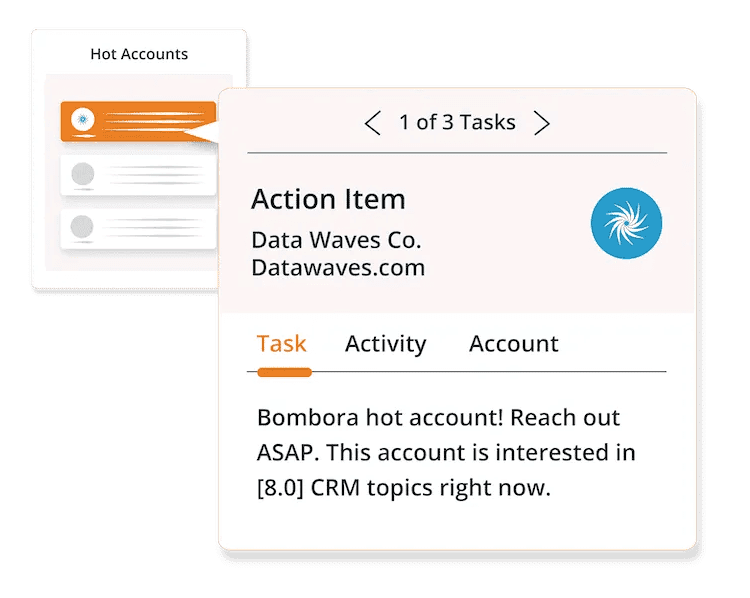
Here’s how it works:
- Company Surge scoring directly in your CRM: Bombora’s intent data identifies when businesses are actively researching specific topics. That Surge score can then be sent directly to your CRM of choice, meaning sales teams see directly on the lead page when there’s been a spike in interest.
- Lead scoring enhancement: Bombora adds a layer of intent data to your lead scoring, which helps sales teams prioritize the accounts that are more likely to be in-market.
- Insights into key topics: Using Bombora’s intent data, sales teams can monitor which topics their prospects are interested in, meaning they can tailor their messaging to the pain points and challenges that matter most.
Key takeaways:
- In this case as well, 6sense wins as an all-in-one system. If you want all of your data and actions to be in one place, this is a good option. The downside is that both Sales and Marketing will need to learn how to use this system.
- Bombora wins for sales teams who already have an established tech stack and simply want to layer in intent data to their lead scoring and prioritization. It’s easy to set up and integrate into an existing workflow.
Want to give Sales insights they can actually use?
Vague, account-level data isn’t helpful to sales teams. You know those cool notifications that say “Big Fish Company is researching a topic somewhat related to your product”? Yeah, most salespeople ignore those (sorry to burst your bubble).
So, what kind of data can sales teams actually use?
The kind that tells them:
- Who is interested
- What caught their attention
- When they’re still engaged
That’s the kind of data that Influ2 can give your sales team.
Strengths and weaknesses of 6sense and Bombora (and how they work together)
Want to know which tool is right for you? Let’s talk about where each one is strong, as well as their weak points.
Ease of use and onboarding
Let’s not beat around the bush: 6sense is not easy to set up and start using.
With great power comes complexity, and the depth of the platform means it requires a lot more time on the frontend to learn. For Marketing teams, this is an investment in time that pays off somewhat faster. But for Sales teams whose time is often stretched even thinner, the need to learn an entirely new system can make it more difficult to get and maintain buy-in.
On the other hand, users say that Bombora has a much faster startup time, and it’s quicker to see the ROI.
As one user explains: “Bombora Company Surge is straightforward and easy to use. I came in with no prior experience and was quickly able to master the tool. It provides us a ton of benefits.”
Overall ABM capabilities
6sense is an all-in-one ABM tool, meaning you get AI-driven predictive analytics, intent data, and engagement tools all together. You can build your target audiences, segment accounts, set up workflows, and build advertising campaigns in one place.
The benefit of this is that your team uses one system, and you have one single source of truth for your entire ABM motion. The downside is that your whole team will have to learn and master a new system outside of their current stack.
Bombora doesn’t offer a complete ABM solution on its own, but its strength is its adaptability. Bombora focuses on giving you intent data that your team can use across the board, in whatever tools already form part of their daily workflow.
How 6sense and Bombora work together
While many times these tools are presented as competitors, they actually complement each other. 6sense is a Bombora-powered partner, which in practice means that Bombora’s Company Surge data is built into 6sense for its customers. Conversely, Bombora customers can plug their data into 6sense’s predictive models.
Together, this creates a powerful feedback loop: Bombora tells you which accounts are spiking on key topics, and 6sense’s AI then uses that to refine account scores and triggers.
Building contact-level advertising into your ABM tech stack
You shouldn’t buy an ABM platform just to spray ads at an entire company and hope the right person sees them.
Here’s the thing: both 6sense and Bombora can tell you which accounts are likely to be in-market. But they can’t tell you who at that account is actually engaging. And they can’t target ads to that specific person.
That’s where Influ2 comes in. It’s built for the way B2B buying actually happens—with multiple stakeholders, long sales cycles, and a need for precision to move things forward.
With contact-level ABM, you can focus on the people who make decisions, not just the companies they work for.
And you’re giving sales the data they need to start real conversations.
Book a demo today to see how Influ2 can maximize bring your ABM to the contact level.
Dominique Jackson is a Content Marketer Manager at Influ2. Over the past 10 years, he has worked with startups and enterprise B2B SaaS companies to boost pipeline and revenue through strategic content initiatives.


